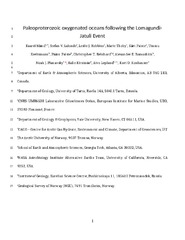Palaeoproterozoic oxygenated oceans following the Lomagundi–Jatuli Event
Permanent lenke
https://hdl.handle.net/10037/19269Åpne
Akseptert manusversjon (PDF)
Akseptert manusversjon (PDF)
Dato
2020-03-16Type
Journal articleTidsskriftartikkel
Peer reviewed
Forfatter
Mänd, Kaarel; Lalonde, Stefan V.; Robbins, Leslie J.; Thoby, Marie; Paiste, Kärt; Kreitsmann, Timmu; Paiste, Päärn; Reinhard, Christopher T.; Romashkin, Alexandr E.; Planavsky, Noah J.; Kirsimäe, Kalle; Lepland, Aivo; Konhauser, Kurt O.Sammendrag
The approximately 2,220–2,060 million years old Lomagundi–Jatuli Event was the longest positive carbon isotope excursion in Earth history and is traditionally interpreted to reflect an increased organic carbon burial and a transient rise in atmospheric O2. However, it is widely held that O2 levels collapsed for more than a billion years after this. Here we show that black shales postdating the Lomagundi–Jatuli Event from the approximately 2,000 million years old Zaonega Formation contain the highest redox-sensitive trace metal concentrations reported in sediments deposited before the Neoproterozoic (maximum concentrations of Mo = 1,009 μg g−1, U = 238 μg g−1 and Re = 516 ng g−1). This unit also contains the most positive Precambrian shale U isotope values measured to date (maximum 238U/235U ratio of 0.79‰), which provides novel evidence that there was a transition to modern-like biogeochemical cycling during the Palaeoproterozoic. Although these records do not preclude a return to anoxia during the Palaeoproterozoic, they uniquely suggest that the oceans remained well-oxygenated millions of years after the termination of the Lomagundi–Jatuli Event.
Forlag
Springer NatureSitering
Mänd K, Lalonde, Robbins, Thoby, Paiste K, Kreitsmann T, Paiste P, Reinhard, Romashkin, Planavsky, Kirsimäe K, Lepland A, Konhauser KO. Palaeoproterozoic oxygenated oceans following the Lomagundi–Jatuli Event. Nature Geoscience. 2020;13(4):302-306Metadata
Vis full innførselSamlinger
Copyright 2020 Springer Nature


 English
English norsk
norsk